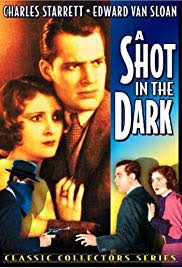
The main mystery is why such a complicated plot?
Byron Coates is a college student. His roommate Ken Harris (Charles Starrett) finds him hanging by a noose outside the window of his dorm room. Ken wakes up Charlie Penlon (Julian Madison). Charlie pulls Byron’s body into the room while Ken calls Dr. Howell (Broaderick O’Farrell) and his father Joseph Harris (Robert Warwick) then he phones Professor Bostwick (Edward Van Sloan). The doctor examines Byron and determines that he was dead before the rope was put around his neck. Ken then goes to the local hotel and tells Byron’s Aunt Lucille (Doris Lloyd).
Bill Smart (Eddie Tamblyn) says he talked to Byron the night before around 11:00. Later he talked to him again around 11:30. Bill says Byron had a visitor but he doesn’t know who. Charlie runs into Sam Anderson (Ralph Brooks). Sam says he needs to talk to Ken. He says he knows who was in Byron’s room the night before but he needs to go to choir practice. He doesn’t want to reveal the name of the person until he talks to Ken.
The autopsy reveals that Byron was killed by a needle that penetrated the back of his skull and into his brain. A lot of force was used. Later, before he can reveal what he knows Sam is killed. The autopsy for Sam shows that he was killed the same way as Byron. A needle was shot from some type of weapon into the base of his neck and into his skull.
While investigating, Joseph finds that Byron was to come into a great deal of money on his twenty-first birthday. That day was today.
“A Shot in the Dark” was released in 1935 and was directed by Charles Lamont. Lamont directed quite a few Abbott and Costello and Ma and Pa Kettle movies. The film was based on the novel “The Dartmouth Murders” by Clifford Orr.
There are a couple twists and turns and more than one red herring. Part of it is predictable and part of it is a little far fetched. Everyone is a suspect and everyone pretty much acts like a suspect. There’s more than one person killed at the moment they are about to tell some critical piece of information. Many who-done-it tropes are used as plot devises which was standard fodder for a lot of 1930’s mysteries. It seemed like; in this case, they used more than was needed.
The plot itself seemed very involved and unnecessary. Some misdirection is desirable but it felt like there were too many suspects. I thought it could have been better if it had been trimmed down a little. Not that the movie was long, but it needed a little more punch to it. Fewer suspects and more character development. It was a lot of people coming and going. Each one had a piece of information and without a score card I lost track of who was who and did they mean anything to the story.
In all, the movie was fine for a rainy afternoon and I enjoyed it. It was a nice mystery, it just wasn’t a thriller.

